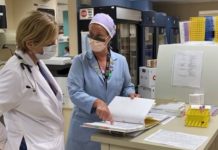Combining private sector investment with leading research from the University of Windsor, Windsor-Essex is a medical research powerhouse.
State-of-the-art innovative technology and research developed in Windsor- Essex is changing the way the art world authenticates paintings, improves medical diagnostics through proprietary manufacturing capabilities and provides hope for those suffering from cancer.
Combining private sector investment and research at the University of Windsor is at the heart of two projects while another is the result of two innovative companies – Suntrition Inc. and Biomedcore Inc. – joining together as Acenzia Inc. to fulfill a common vision of making a difference in the outcome of chronic illnesses, including cancer.
The Institute for Diagnostic Imaging Research, headed by Dr. Roman Maev of the University of Windsor, features an art analysis team consisting of restorers, art conservators and appraisers who use thermography to analyse paintings and find defects and reveal alterations under the surface of the painting.
“We can use a variety of processes because every piece of art can be different,” said Maev. “It might be on wood, on metal, on canvas and all need to be analysed differently. It can be done by thermography or by spectral analysis but it is all non-invasive and does not affect the painting.”
“We are also able to authenticate the period in which a painting was made by using spectral analysis to determine what kind of paint was used and what its chemical properties are,” said Maev. “Certain types of paint were used in certain time periods and we can analyse that non-invasively”
Maev’s art team has been employed by the United Kingdom’s National Gallery, Cambridge University and the Pushkin State Museum of Fine Art in Moscow.
Maev recently gave a presentation on the subject to representatives of the art world at Canada House in London.
“It’s a growing business and we are trying to get more organized so we can take on more clients,” said Maev.
Art forgery is a multi-billion-dollar crime on a worldwide scale and the IDIR’s technology is being used to authenticate paintings and provide quality control as well as non-destructive and non-invasive analysis.
The institute, which has developed a world-wide reputation since being established in 2008, has also developed technology in the fields of nanotechnology, biomedical research, acoustical microscopy and biometrics, all with a focus on commercializing results generated by its cutting-edge research.
It’s not the only cutting-edge research being conducted in the Windsor-Essex Region. At Acenzia, the merged result of Biomedcore and Suntrition coming together, president and CEO Gordon Moore said that both companies bring something distinct to the partnership: Biomedcore’s research into using Zebrafish to help identify drug sensitivity for patients with chronic illnesses including cancer, and Suntrition’s R & D into standardizing Natural Health Product raw materials to ensure batch to batch consistency and efficacy for their clients and the consumer.
“We are able to inject live tumour cells into Zebrafish where they grow and behave similar to what the patient experiences. We are then able to assist the oncologist to determine dosing plans for that cancer patient by observing how chemotherapy affects the tumour in the fish,” said Moore. “This allows the oncologist to identify the treatment that is best for each individual patient.”
Moore said that taking biopsies from lung cancer patients can be difficult, and dangerous to the patient, but Acenzia’s technology can also use simple blood samples, as specialized equipment is able to separate Circulating Tumour Cells from normal cells in the blood. These cells are then injected into the Zebrafish to once again help determine the best course of chemotherapy treatment for each patient.
Chief Scientific Officer Dr. Indrajit Sinha (former CEO of Biomedcore) and Grant Bourdeau (former CEO of Suntrition) had the common vision and insight to make Acenzia a technological pioneer that will help the diagnosis and treatment of chronic illnesses and also help to revolutionize the natural health product industry.
Meanwhile at the University of Windsor, Dr. Siyaram Pandey is leading cutting-edge research into cancer treatment at the Kevin Couvillon Research Project at Windsor Regional Cancer Centre through the use of dandelion extract.
Clinical trials, focusing on those suffering from blood-borne cancers such as leukemia, began a year ago “There is no question that patients using dandelion root extract have had positive responses,” said Pandey. “We are now awaiting the results of the clinical trials to confirm those responses. The extract is absorbed by the body and goes directly to the cancer cells and we have had some very positive outcomes in our testing.
“It’s a very exciting development,” said Pandey. “At the moment, it is for people have exhausted other forms of treatment which is making it more difficult to recruit patients for the clinical trials but we remain very confident.”
Across the region, there are more than 50 companies actively involved in the fast-growing life sciences field, employing more than 1,800 people.
Other companies such as Jamieson Laboratories, Accucaps and NutraNorth are all taking advantage of a highly-skilled manufacturing workforce accustomed to working with extremely tight tolerances and a variety of materials. In addition to 10 pharmaceutical and medicine manufacturers, there are 43 other companies manufacturing measuring, medical and control devices as well as medical equipment and supplies.
The region’s proximity to Detroit opens up opportunities for cross-border medical research studies, a diverse population for clinical trials and a direct link between Canadian and U.S. health networks including Henry Ford Health Systems, with its seven hospitals and 40 medical centres, and the Detroit Medical Centre.
The University of Windsor’s Schulich School of Medicine and Dentistry provides area students with first-rate medical education and training and St. Clair College turns out skilled graduates from its Centre for Applied Health Services.
















